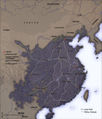Image:Qin empire 210 BCE.png
From Wikipedia, the free encyclopedia

Qin_empire_210_BCE.png (555 × 545 pixel, file size: 540 KB, MIME type: image/png)
Commentary
As part of his unification of China in 221 BC, Qin Shi Huang divided his empire into thirty six commanderies, each subdivided into a number of counties. The significance of the administrative reforms was its introduction of a uniformly centralised system of imperial control. The system was followed by the Han Dynasty, though with a certain degree of compromise. Thereafter, the system became the norm for later dynasties and eventually evolved into the present administrative structure of Mainland China. See: Political divisions of China.
The location of the Yellow River and commandery seats follows Tan Qixiang (ed.), Zhongguo lishi ditu (中国历史地图集), 1982. Note that the Yellow River is considerably to the north of its present flow.
The coloured territories show the approximate extent of Qin political control at the death of Qin Shi Huang in 210 BC. At that time more commanderies were added to the original thirty six, and these are also shown on the map.
Created and copyright (2006) by Yeu Ninje. Released under the GNU FDL.
Licensing
I, the creator of this work, hereby grant the permission to copy, distribute and/or modify this document under the terms of the GNU Free Documentation License, Version 1.2 or any later version published by the Free Software Foundation; with no Invariant Sections, no Front-Cover Texts, and no Back-Cover Texts.
Subject to disclaimers.
Related images
File history
Legend: (cur) = this is the current file, (del) = delete this old version, (rev) = revert to this old version.
Click on date to download the file or see the image uploaded on that date.
- (del) (cur) 09:31, 14 June 2006 . . Yeu Ninje ( Talk | contribs) . . 555×545 (553,405 bytes)
-
Edit this file using an external application
See the setup instructions for more information.
File links
- Qin Dynasty
- User:Yeu Ninje/Maps
- Historical Atlas of China
Categories: Images for cleanup | Articles lacking sources from December 2006 | All articles lacking sources | Maps of the history of China | User-created GFDL images


